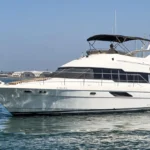When it comes to maintaining the performance and longevity of your yacht’s twin diesel engines, the cooling system plays a critical role. Diesel engines generate a tremendous amount of heat, and without an efficient cooling system, they would quickly overheat, leading to potential engine damage or failure. In this post, we’ll explore how the cooling system on a twin diesel yacht works and what it takes to keep it in top shape.
How a Twin Diesel Engine Cooling System Works
Most twin diesel yachts use a closed-loop cooling system that consists of two primary circuits:
- Raw Water Circuit – This is the external cooling loop that draws seawater through an intake, usually located on the hull. The seawater passes through a heat exchanger, where it absorbs heat from the coolant before being expelled back into the ocean. In some systems, this seawater also cools the exhaust system.
- Freshwater Circuit – This is the internal cooling loop that circulates coolant (a mix of water and antifreeze) through the engine block, absorbing heat. The heated coolant then passes through the heat exchanger, where it transfers heat to the raw water before recirculating through the engine.
In addition to the heat exchanger, the cooling system includes components such as:
- Seawater Strainers – These prevent debris from entering the cooling system.
- Coolant Pumps – Move coolant through the system.
- Thermostats – Regulate coolant flow based on engine temperature.
- Expansion Tanks – Allow for coolant expansion as it heats up.
- Aftercoolers/Intercoolers – Cool intake air for better combustion efficiency.
Cooling System Maintenance Requirements
To ensure your yacht’s twin diesel cooling system remains efficient and reliable, regular maintenance is essential. Here’s what you need to focus on:
1. Inspect and Clean Raw Water Strainers
Seawater strainers can clog with debris, reducing water flow and increasing the risk of overheating. Check and clean them regularly, especially when operating in areas with high debris or marine growth.
2. Check and Replace Coolant
Over time, coolant degrades and loses its ability to effectively transfer heat and prevent corrosion. It’s crucial to check coolant levels before each voyage and replace it according to the manufacturer’s recommendations.
3. Flush the Heat Exchanger
The heat exchanger is a key component, and scale buildup can reduce its efficiency. Periodically flushing it with a descaling solution helps maintain optimal heat transfer.
4. Inspect and Replace Impellers
The raw water pump’s impeller is responsible for drawing seawater into the system. These rubber components wear out over time and should be inspected and replaced annually or at the first sign of wear.
5. Check Hoses and Clamps
Cooling system hoses should be inspected for cracks, leaks, or signs of wear. Clamps should be tight and corrosion-free to prevent coolant leaks.
6. Monitor Engine Temperature
Keep an eye on your engine temperature gauges while underway. A sudden rise in temperature could indicate a blocked intake, failing pump, or thermostat issue.
7. Service the Thermostats
Thermostats regulate coolant flow to maintain engine temperature. They should be tested and replaced periodically to ensure proper function.
Final Thoughts
A properly maintained cooling system is essential for the safe and efficient operation of a twin diesel yacht. By following a routine maintenance schedule and addressing potential issues early, you can prevent costly repairs and extend the life of your engines. Whether you handle maintenance yourself or rely on a marine mechanic, staying proactive with your cooling system care will keep your yacht running smoothly for years to come.
Need help with your yacht’s cooling system maintenance? Get in touch with our team for expert advice and service!





